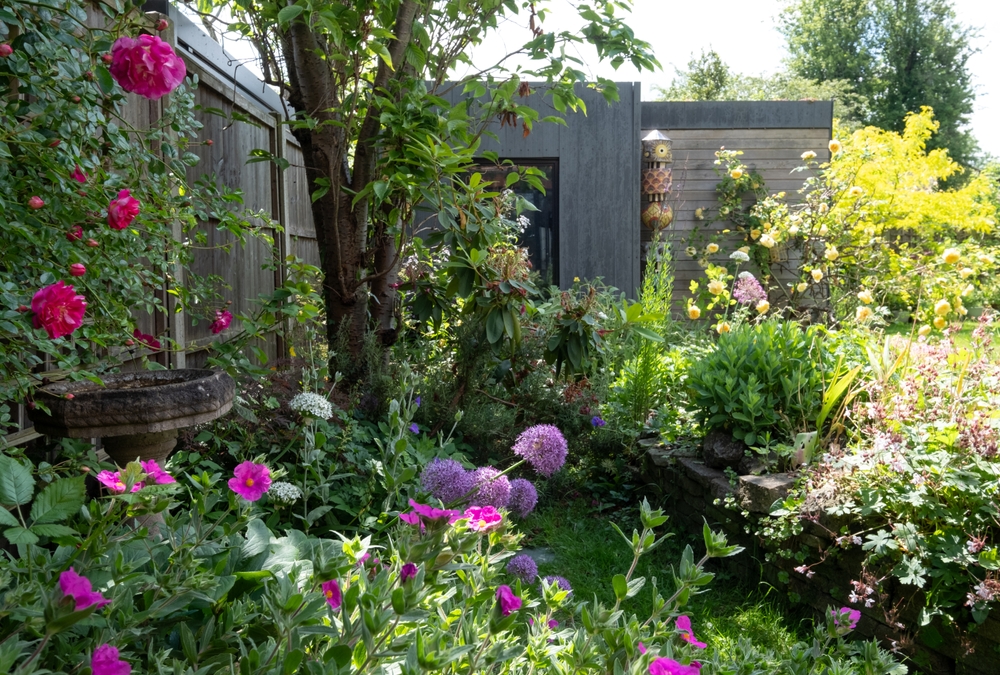Gardening is a wonderful way to connect with nature and contribute to a healthier planet. By adopting sustainable gardening practices, you can create a beautiful and eco-friendly space, even on a small balcony or a large backyard.
Sustainable gardening practices offer both environmental and economic advantages. By using recycled materials, reducing water and fertilizer usage, and choosing low-maintenance plants, you can save money and resources.
In this post, we will share various tips and strategies to make your garden more sustainable. We will also discuss eco-friendly gardening ideas, sustainable planting techniques, and ways to attract wildlife to your garden.

Lois GoBe Shutterstock
What is Eco-Friendly Gardening?
Eco-gardening is a sustainable approach to gardening that prioritizes harmony with nature. It involves practices that promote biodiversity, minimize waste and pollution and conserve resources. An eco-garden isn’t solely defined by the plants it contains but also by the design principles, care methods, and interactions. These come together to foster a healthy ecosystem. By adopting eco-friendly practices, gardeners can create beautiful and environmentally responsible outdoor spaces.
Why Sustainable Gardening Matters
Sustainable gardening is a holistic approach to cultivating outdoor spaces. It focuses on environmentally friendly practices that benefit both the environment and human well-being. With sustainable gardening techniques, individuals can contribute to combating climate change, supporting local wildlife, and fostering a healthier ecosystem. This approach encourages the use of environmentally friendly materials, water conservation methods, and the planting of native plant species. Ultimately, sustainable gardening promotes a harmonious relationship between humans and nature. Therefore, ensuring a greener and more resilient future.
Eco-friendly Gardening Tips
Avoid Chemicals
For a healthier and more sustainable garden, opt for organic alternatives to chemical weedkillers, fertilizers, and pest control. Chemical products degrade soil quality, contaminate water bodies, and endanger diverse wildlife, including birds, butterflies, hedgehogs, and amphibians.
Prioritize prevention over cure. Foster a balanced garden ecosystem by providing food, shelter, and plants that support various wildlife. Birds can control aphids, amphibians can manage slugs, and hedgehogs can regulate insect populations. If infestations persist, consider natural remedies like soapy water, garlic spray, or beer traps.
Reduce Waste
Gardening doesn’t have to be wasteful. Fallen leaves can be transformed into nutrient-rich leaf mould, perfect for mulching your plants. Small branches and twigs can provide shelter for beneficial insects. Empty compost bags can be repurposed as liners for wooden planters to extend their life. Excess seedlings can bring joy to friends and neighbours. Finally, grass clippings and other plant waste can be composted to enrich your soil. Implementing these simple practices can help reduce waste and foster a more eco-friendly garden.
Recycling
Your eco-friendly garden is incomplete without the use of sustainable home decor and garden elements such as composite cladding panels, bamboo patio furniture and much more.
This concept can also entail transforming everyday objects like washing-up bowls and wheelbarrows into unique garden features. Also, containers of all shapes and sizes can be repurposed as planters, bird baths, or mini ponds. Even broken bricks and chipped saucers can find new life as crocks or bird baths.
Don’t forget about household waste! Large cardboard boxes can be used to suppress weeds, while plastic milk bottles can be cut in half to create DIY cloches. Plastic trays and even toilet roll tubes are perfect for starting seeds. Let your imagination run wild and breathe new life into your garden with these simple, eco-friendly ideas.
Water Wisely
Rainwater harvesting is a sustainable, budget-friendly way to water your garden. By collecting rainwater in water butts or large containers, you can reduce your reliance on tap water. It often involves energy-intensive treatment and transportation processes. This simple practice helps conserve water resources and minimizes your carbon footprint.
Greywater, the water from baths, showers, and sinks, can also be used to irrigate non-edible plants. While it may contain soap residue, it’s generally safe for most garden plants. However, it is advisable to avoid using greywater on edible plants to prevent potential contamination.
Make Your Own Compost and Fertilizer
Composting offers a sustainable and cost-effective way to manage organic waste. By repurposing kitchen scraps and garden trimmings, you can create nutrient-rich fertilizer. This reduces reliance on store-bought products and minimizes environmental impact. To start composting, simply layer soft, green materials like grass clippings and fruit peels with dry, brown materials such as dead leaves and cardboard. As the mixture decomposes, it transforms into a valuable soil amendment.
For an additional boost, consider creating a homemade liquid fertilizer using nettles or comfrey. Steep the chopped plant material in water for several weeks, then dilute the resulting liquid before applying it to your garden. While the process may be less pleasant, the nutrient-rich solution will benefit your plants and reduce your need for chemical fertilizers.
Conclusion
By carefully following these recommended gardening practices, you can create a sustainable garden. Organic gardening harmonizes with nature, promoting biodiversity and soil health.
Remember, sustainability is an ongoing process. Regularly evaluate your gardening habits and explore opportunities to reduce your environmental impact. From minimizing chemical use to conserving water and providing shelter for wildlife. Every action, no matter how small, contributes to a greener future. This will help create gardens that are both beautiful and beneficial to the planet.

